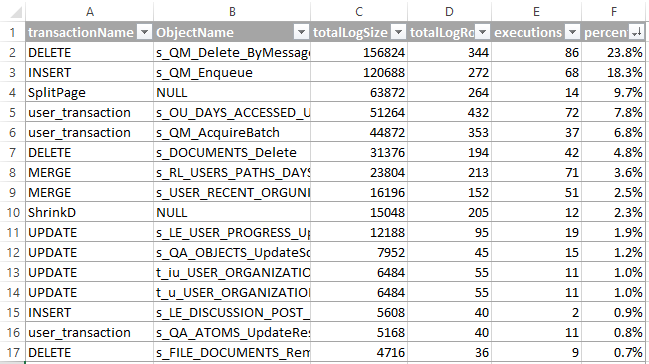Takeaway: WRITELOG waits are associated with a busy or slow transaction log. To tackle these waits, we need to measure transaction log activity. I describe a lightweight way to examine transaction log usage for busy OLTP systems.

Start with Microsoft’s Advice: I’m not going to introduce the topic of transaction log performance. Microsoft’s SQL Customer Advisory Team already provides a great introduction with Diagnosing Transaction Log Performance Issues and Limits of the Log Manager. Their advice includes watching the “Log Bytes Flushed/sec” performance counter found in the “SQL Server:Databases” object.
Reactive Efforts: If you’re curious about transaction log activity for open transactions, Paul Randal has a script at Script: open transactions with text and plans.
Spiky Activity: It’s not too difficult to find infrequent activities that write a lot of data to the transaction log; activities like data warehouse ETLs, or index rebuilds. Use a trace or extended events to look for statements with large values for “writes”.
Scalability of OLTP Workloads
WRITELOG waits are a scalability challenge for OLTP workloads under load. Chris Adkin has a lot of experience tuning SQL Server for high-volume OLTP workloads. So I’m going to follow his advice when he writes we should minimize the amount logging generated. And because I can’t improve something if I can’t measure it, it leads very naturally to this question: What’s generating the most logging? OLTP workloads are characterized by a very frequent tiny transactions so I want to measure that activity without filters, but I want to have as little impact to the system as I can. That’s my challenge.
Getting #SQLHelp
So I asked twitter. And I got some great advice from Erin Stellato:
Erin also pointed out to me the UI warns you that it’s a very high volume event.
Combining fn_dblog With Extended Events
So to avoid that kind of volume, I got the idea to read straight from the transaction log and combine that with a lighter extended events session to get the SQL text. The transaction_id captured by the extended events session corresponds to the XAct ID column in fn_dblog.
Here’s how that went:
The Script
The details for this script are kind of fussy, but it all comes together in a solution that won’t drag a server down. Care is still recommended; start with 10 seconds and go from there.
declare @Duration varchar(10)='00:00:10'; declare @FileSize varchar(10)='5'; -- in megabytes -- create sessionDECLARE @CreateSessionSQL nvarchar(max)= N' CREATE EVENT SESSION query_writes ON SERVER ADD EVENT sqlserver.sp_statement_completed ( SET collect_statement=(0) ACTION(sqlserver.transaction_id, sqlserver.database_name) WHERE sqlserver.transaction_id > 0 AND sqlserver.database_name = '''+DB_NAME()+ N''') ADD TARGET package0.asynchronous_file_target( SET filename = N''query_writes.xel'', max_file_size = '+ @FileSize + N', max_rollover_files = 1) WITH ( STARTUP_STATE=ON, EVENT_RETENTION_MODE=ALLOW_SINGLE_EVENT_LOSS, TRACK_CAUSALITY=OFF)'; execsp_executesql @CreateSessionSQL; ALTER EVENT SESSION query_writes ON SERVER STATE=START; -- get the latest lsn for current DBdeclare @xact_seqno binary(10); declare @xact_seqno_string_begin varchar(50); exec sp_replincrementlsn @xact_seqno OUTPUT; set @xact_seqno_string_begin ='0x'+CONVERT(varchar(50), @xact_seqno, 2); set @xact_seqno_string_begin =stuff(@xact_seqno_string_begin, 11, 0, ':')set @xact_seqno_string_begin =stuff(@xact_seqno_string_begin, 20, 0, ':'); -- wait a minutewaitfor delay @Duration; -- get the latest lsn for current DBdeclare @xact_seqno_string_end varchar(50); exec sp_replincrementlsn @xact_seqno OUTPUT; set @xact_seqno_string_end ='0x'+CONVERT(varchar(50), @xact_seqno, 2); set @xact_seqno_string_end =stuff(@xact_seqno_string_end, 11, 0, ':')set @xact_seqno_string_end =stuff(@xact_seqno_string_end, 20, 0, ':'); -- Stop the sessionALTER EVENT SESSION query_writes ON SERVER STATE=STOP; -- read from transaction logselectmax([Xact ID])as transactionId, max([Transaction Name])as transactionName, sum([Log Record Length])as logSize, count(*)as[logRowCount]into #TLOGS from fn_dblog(@xact_seqno_string_begin, @xact_seqno_string_end) f groupby[Transaction Id] -- read from session dataCREATETABLE #SessionData ( id intidentityprimarykey, XEXml xml NOTNULL) INSERT #SessionData(XEXml)SELECTCAST(fileData.[event_data]as xml)FROM sys.fn_xe_file_target_read_file('query_writes*xel', null, null, null) fileData; -- find minimum transactionId captured by xes -- (almost always the first one, depending on luck here)declare @minTXFromSession bigint; selectTOP(1) @minTXFromSession = S.XEXml.value('(/event/action[(@name=''transaction_id'')]/value)[1]', 'bigint')from #SessionData S; WITH SD AS(SELECT S.XEXml.value('(/event/action[(@name=''transaction_id'')]/value)[1]', 'bigint')as transactionId, S.XEXml.value('(/event/data[(@name=''object_id'')]/value)[1]', 'bigint')as objectId FROM #SessionData S )SELECT ISNULL(T.transactionName, 'Unknown')as transactionTypeName, OBJECT_NAME(S.objectid)as ObjectName, SUM(T.logsize)as totalLogSizeBytes, SUM(T.logRowCount)as totalLogRowCount, COUNT(*)as executions FROM #TLOGS T LEFTJOIN(SELECTDISTINCT*FROM SD) S ON T.transactionId= S.transactionIdWHERE T.transactionId>= @minTXFromSession GROUPBY T.transactionName, S.objectIdORDERBYSUM(T.logsize)DESC -- clean upDROP EVENT SESSION query_writes ON SERVER; DROPTABLE #TLOGS DROPTABLE #SessionData |
Sample Results
Here’s an example of what the results would look like. It’s an aggregated view of all transaction log activity in a database for 10 seconds.
Notes
- Notice that the session is database specific. That’s because transaction logs are database specific. To help focus on the right database, use the “Log Bytes Flushed/sec” performance counter found in the “SQL Server:Databases” object.
- Also notice that I’m tracking ObjectIds. That’s because we use procedures quite heavily. You may want to adapt this code to use query_hash instead. In both cases, collecting the statement text is not recommended.
- The sample of data is limited by the size of the extended events target file or the duration variable, whichever is smaller.
- @sqL_handLe pointed out to me that reading the log using
fn_dblogwill prevent the transaction log from truncating. Reading from the transaction log can be very tricky to do efficiently. Luckily we can use thesp_replincrementlsntrick to get LSN parameter values forfn_dblog.